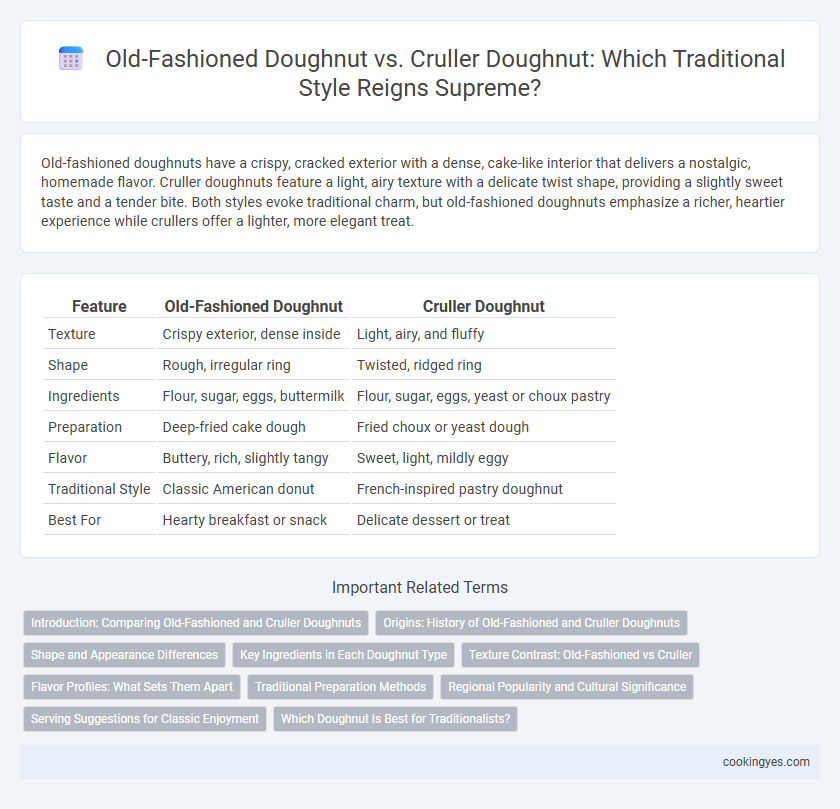Old-fashioned doughnuts have a crispy, cracked exterior with a dense, cake-like interior that delivers a nostalgic, homemade flavor. Cruller doughnuts feature a light, airy texture with a delicate twist shape, providing a slightly sweet taste and a tender bite. Both styles evoke traditional charm, but old-fashioned doughnuts emphasize a richer, heartier experience while crullers offer a lighter, more elegant treat.
Table of Comparison
| Feature | Old-Fashioned Doughnut | Cruller Doughnut |
|---|---|---|
| Texture | Crispy exterior, dense inside | Light, airy, and fluffy |
| Shape | Rough, irregular ring | Twisted, ridged ring |
| Ingredients | Flour, sugar, eggs, buttermilk | Flour, sugar, eggs, yeast or choux pastry |
| Preparation | Deep-fried cake dough | Fried choux or yeast dough |
| Flavor | Buttery, rich, slightly tangy | Sweet, light, mildly eggy |
| Traditional Style | Classic American donut | French-inspired pastry doughnut |
| Best For | Hearty breakfast or snack | Delicate dessert or treat |
Introduction: Comparing Old-Fashioned and Cruller Doughnuts
Old-Fashioned doughnuts feature a dense, cake-like texture with a cracked, irregular surface, offering a rich buttery flavor ideal for traditional palates. Cruller doughnuts, characterized by their light, airy texture and twisted shape, provide a crisp exterior and tender inside, making them a popular choice in classic doughnut assortments. Both styles reflect timeless doughnut-making techniques rooted in American confectionery heritage.
Origins: History of Old-Fashioned and Cruller Doughnuts
Old-fashioned doughnuts originated in the early 20th century, known for their dense, cake-like texture and cracked surface, often attributed to their oil frying method. Cruller doughnuts trace back to Dutch settlers in America, characterized by their twisted or braided shape and a lighter, airy consistency achieved through a choux pastry technique. Both styles represent distinct historical baking traditions, reflecting regional influences and evolving American tastes in traditional doughnut craftsmanship.
Shape and Appearance Differences
Old-fashioned doughnuts feature a rough, irregular, cracked surface with a thicker, cakey texture and a flat, ring shape. Cruller doughnuts have a twisted or braided appearance with ridged edges, often lighter and airier due to their choux pastry base. The distinct shapes and textures highlight traditional styles: the dense, rustic charm of old-fashioned doughnuts contrasts with the delicate, intricate design of crullers.
Key Ingredients in Each Doughnut Type
Old-fashioned doughnuts feature a batter made with flour, sugar, baking powder, eggs, milk, and butter, giving them a dense and cakey texture. Cruller doughnuts rely on a choux pastry dough containing flour, eggs, water, and butter, resulting in a light and airy interior with a ridged shape. The key distinction in ingredients is the use of chemical leaveners in old-fashioned doughnuts versus steam-leavened choux dough in crullers.
Texture Contrast: Old-Fashioned vs Cruller
Old-fashioned doughnuts have a dense, cake-like texture with a slightly crispy, cracked exterior that provides a satisfying chew. Cruller doughnuts are lighter and airier due to their twisted shape and fried, flaky layers, offering a tender bite with a delicate crispness. The texture contrast highlights the old-fashioned doughnut's hearty, substantial feel against the cruller's light and airy quality.
Flavor Profiles: What Sets Them Apart
Old-fashioned doughnuts boast a crisp, cracked surface with a dense, cakey texture and a rich buttery flavor enhanced by vanilla and nutmeg. Cruller doughnuts, often light and airy with a twisted shape, feature a tender crumb and a subtly sweet taste, typically glazed for added sweetness. The distinct flavor profiles stem from their differing batters and frying techniques, making old-fashioned doughnuts sturdier and more intensely flavored than the delicate, melt-in-your-mouth cruller.
Traditional Preparation Methods
Old-fashioned doughnuts feature a dense, cake-like texture achieved through the use of a chemical leavening agent like baking powder, and frying at a lower temperature to create a crackly, crisp exterior. Cruller doughnuts employ a pate a choux dough, which is first boiled then fried, resulting in a light, airy interior with ridged, twisted shapes formed by piping the dough. Both styles rely on traditional frying techniques but differ significantly in dough composition and texture, reflecting distinct regional and cultural influences in classic doughnut preparation.
Regional Popularity and Cultural Significance
Old-fashioned doughnuts hold a strong regional popularity in the Midwest and Southern United States, renowned for their dense, cake-like texture and crisp edges that evoke a nostalgic, hearty tradition. Cruller doughnuts, especially popular in Northeastern states and parts of Canada, feature a light, airy texture with a twisted shape, symbolizing European pastry influences and often enjoyed during festive occasions. Both varieties reflect deep cultural significance, with old-fashioned doughnuts linked to classic Americana and crullers embodying multicultural heritage in traditional pastry celebrations.
Serving Suggestions for Classic Enjoyment
Old-fashioned doughnuts pair perfectly with a dusting of powdered sugar or a simple glaze to highlight their crisp edges and tender crumb, making them ideal for coffee or hot chocolate accompaniments. Cruller doughnuts, with their light and airy texture, serve well when dipped in flavored icings or served alongside fresh fruit preserves for a classic afternoon treat. Both traditional styles are best enjoyed fresh, emphasizing their unique textures and enhancing the nostalgic experience of a timeless doughnut indulgence.
Which Doughnut Is Best for Traditionalists?
Old-fashioned doughnuts offer a classic, dense texture with a perfectly cracked, crisp exterior that traditionalists favor for an authentic experience. Cruller doughnuts, known for their light, airy, and twisted shape, provide a different texture but may not satisfy those seeking a truly nostalgic taste. Traditional doughnut lovers often choose old-fashioned doughnuts for their rich, buttery flavor and time-tested recipe that epitomizes classic doughnut craftsmanship.
Old-fashioned doughnut vs Cruller doughnut for traditional style Infographic

 cookingyes.com
cookingyes.com